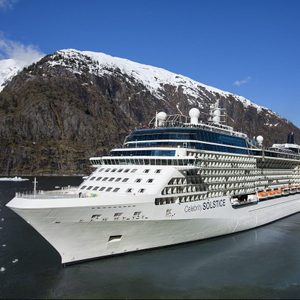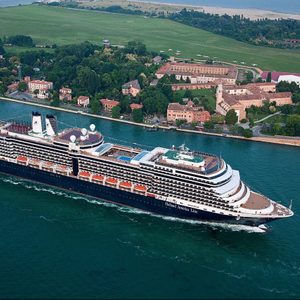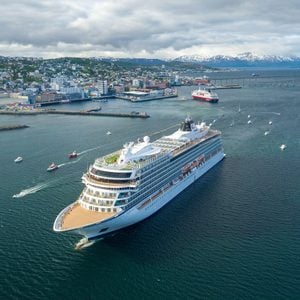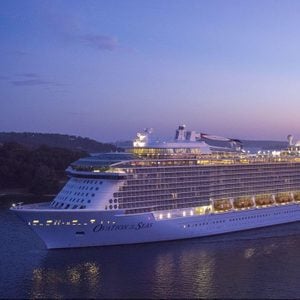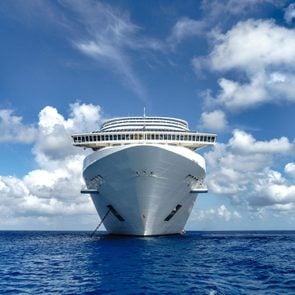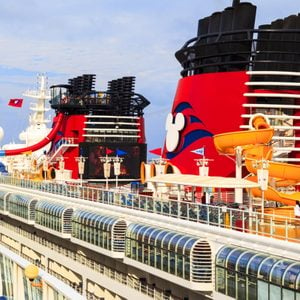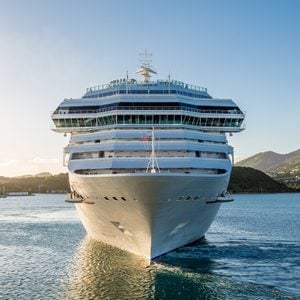Have Cruises Recovered from the Pandemic?
Updated: Mar. 10, 2023
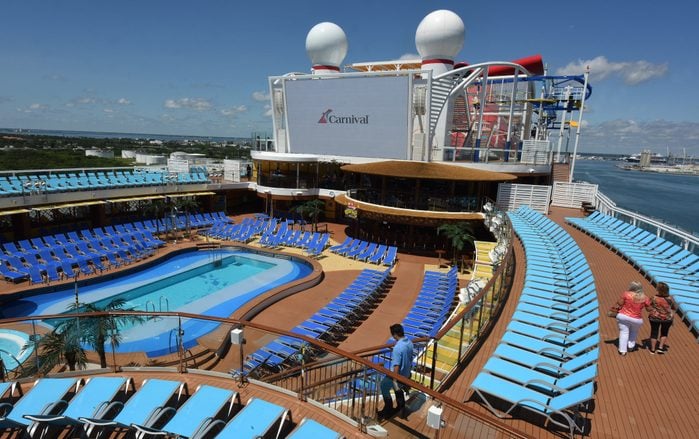
Cruising is back, and the high seas will be busier than ever with recent changes to cruise ship COVID-19 protocols
Our editors and experts handpick every product we feature. We may earn a commission from your purchases.
Two years ago, the pandemic sent the cruise industry into a tailspin. Travelers worried about cruise ship COVID-19 cases, which continued to climb. By the summer of 2020, most cruise lines had suspended operations worldwide—and the entire travel industry came to a standstill. Many cruise ships were docked in ports, while others sat idle at sea.
But you’d never guess that based on the state of the cruise industry today. Cruise terminals are bustling with excited passengers, and cheery crew members welcome voyagers aboard. Sure, you might see the ship’s crew donning face masks, along with a few passengers. And you’ll probably come across a few new sinks for hand-washing and additional hand-sanitizing stations around the ship. But on a whole, whether you’re taking a singles cruise, couples cruise, adults-only cruise or all-inclusive cruise, there are almost no reminders of the pandemic.
People have missed traveling—and cruising—and they’re ready to move beyond the fear of catching “cruise ship COVID-19.” They’re booking the best cruise lines and eagerly packing for a voyage on the high seas. The list of things you can’t do on cruises anymore is shorter than it was a year ago, so as long as you know what to expect, you can enjoy a vacation in open waters.
What’s the CDC’s role in cruise ship COVID-19 safety?
Reducing regulations and restrictions regarding COVID-19 has been the cruise industry’s focus since the pandemic’s beginning. As arguably the hardest-hit industry in the tourism sector—cruise ship COVID-19 fears meant 81% fewer passengers embarked on a cruise in 2020 versus 2019—ships are more than ready to be back and sailing at full capacity.
“During the pause, we worked to carry out protocols that helped make cruising among the safest forms of travel today, and we offered guests a ‘worry-free promise’ so they could feel confident booking a cruise, knowing they would be covered if their plans changed,” says Beth Bodensteiner, senior vice president and chief commercial officer for Holland America Line. “We have approached our fleet’s full return with the safety of guests, crew members and the communities we visit top of mind.”
Even the Centers for Disease Control and Prevention (CDC) agrees that it’s time to move forward. And it’s backing that up with action: As of July 18, 2022, the CDC’s COVID-19 Program for Cruise Ships is no longer in effect.
“Over the past two years, the CDC has worked closely with the cruise industry; state, territorial and local health authorities; and federal and seaport partners to provide a safer and healthier environment for cruise passengers and crew,” says Jasmine Reed, a public affairs specialist for the agency. “CDC has determined that the cruise industry has access to the necessary tools [cruise-specific recommendations and guidance, vaccinations, testing instruments, treatment modalities and non-pharmaceutical interventions] to prevent and mitigate COVID-19 on board.”
But travelers worried about getting sick aboard a cruise ship can rest assured that cruise lines aren’t sailing solo in the continuing pandemic. The CDC is providing support. It’ll still publish guidelines so cruise ships can provide a safe environment for passengers and crew members. “Individual cruise lines will determine their own specific COVID-19-related requirements for cruise travel, as well as safety measures and protocols for passengers traveling on board, based on CDC recommendations for reducing the risk of COVID-19,” Reed says.
What COVID-19 protocols have cruise lines put in place?
With the discontinuation of the CDC’s program, cruise lines are announcing updated COVID-19 protocols. Take, for instance, Norwegian Cruise Line Holdings Ltd., the parent company for Norwegian Cruise Line, Oceania Cruises and Regent Seven Seas Cruises.
“Effective Aug. 1, 2022, we will no longer require guests to complete pre-cruise COVID-19 testing, unless required by local regulations,” a spokesperson for the company said. “The pre-embarkation testing requirement will remain in place for guests traveling on voyages departing from destinations with local testing regulations. The relaxation of the testing policy is in line with the rest of the travel, leisure and hospitality industry worldwide as society continues to adapt and return to a state of normalcy.”
Another company that just announced a change in testing requirements is upmarket cruise line Azamara. Effective July 25, 2022, it will no longer require pre-cruise testing, except in ports where the country requires it. “The easing of our testing policy marks a step in the right direction toward a return to normalcy for the travel and cruising industry,” Carol Cabezas, the president of Azamara, said in a statement.
The situation is evolving, but it’s essential to know that some lines, like Azamara, still require guests 12 years of age or older to be fully vaccinated to sail—that includes a booster shot, if guests are eligible for one. Of course, a requirement for one cruise line may be a nonissue for another.
“With the new CDC announcement regarding the technicality for pre-cruise testing requirements, no onboard mask requirements and even vaccine requirements being relaxed, I think it’s important to stress that cruise lines may interpret this differently,” says Annie Scrivanich, senior vice president of Cruise Specialists, a Seattle-based luxury travel agency. “There are still entry requirements for certain countries and other nuances that will impact travel. Cruisers should stay informed via their travel agent of what to expect when they travel.”
Reed suggests going straight to the source for COVID-19-related cruise advice. “Cruise travelers should contact their cruise line directly for more information regarding the protocols and procedures for COVID-19 safety, which may vary among cruise lines.”
What’s the state of the cruise industry today?
According to Scrivanich, cruise lines are currently sailing between 70% and 100% capacity, depending on the destination. So can you still find a deal? The answer is yes.
“Following the cruise industry’s yearlong pause during the height of COVID, we saw a demand that far exceeded supply,” says Chris Gray Faust, the managing editor of cruise ship review site Cruise Critic. “Cruise lines planned a slow, methodical return to cruising, which meant welcoming back just a few ships and itineraries at a time—all with limited capacity on board.”
Credits for canceled cruises and pent-up demand meant cruise lines had no trouble filling their ships in 2021. Pricing remained stable—no need for the lines to discount fares—throughout the year. But things are different this year, what with reduced restrictions on cruise ships and delayed or canceled flights across the country.
“The cruise lines have all their ships sailing with no capacity restrictions. So we have seen pricing become very attractive for consumers, particularly when other forms of travel, such as flights, hotels and gas, have record-high prices,” Gray Faust says. “For summer 2022 and into fall, cruising is a value proposition, and so while bookings are not quite at 2019 levels yet, cruise shoppers are taking advantage of these deals.”
Cruising closer to home—and flying shorter distances, or not at all—is also trending in the industry. “With the cost and recent challenges with air travel, we are seeing strong interest in cruises that are a short flight or drive from guests’ homes,” Bodensteiner tells us. “Holland America Line visits 225 ports in 91 countries on sailings that are round trip from U.S. ports, including Boston, Fort Lauderdale, San Diego or Seattle. It means travelers can see the world from their doorstep.”
Whether they’re booking scenic American river cruises or gathering the little ones for a cruise with kids across the ocean, travelers are making the most of the reasonable rates. “We have also seen a surge in bookings, with June showing our highest booking levels for Alaska cruises since early 2020,” she says.
Scrivanich also notes an uptick in last-minute bookings (for sailings within six months), especially in Europe and Alaska—no matter the price. “There’s also an increase with guests booking smaller, luxury cruises,” she says. “Clients who have not traveled for the past two years want to treat themselves and do it right!”
Can cruise lines meet the demands?
The cruise industry is no stranger to staffing issues. According to the Cruise Lines International Association, cruise-related jobs dropped by 51% from 2019 to 2020. While cruises have rebounded somewhat, you still may experience issues related to reduced staffing while at sea.
“One region particularly affected is Alaska, where the shoreside personnel staffing levels have impacted excursion availability and staffing,” Gray Faust says. “The state has not seen the same seasonal workforce it enjoyed before the pandemic, and more jobs in Alaska rely on highly skilled workers with specific licenses for small planes, boats and buses.”
Even if there are minor staffing issues in select destinations, passenger feedback on Cruise Critic is positive. “The reviews from recent cruisers show that onboard service is still stellar—ratings for crew service remain incredibly high,” she says. “We recently surveyed travelers who cruised within the past six months, and 89% of those surveyed said they would sail again under the same circumstances. So the cruise lines are delivering an experience that is meeting or exceeding expectations.”
Travelers, it seems, are simply happy to be sailing once again. “Since returning to service a year ago, we have seen record guest satisfaction scores. Our team members and guests are thrilled to be on board again,” Bodensteiner says.
Scrivanich’s clients are also pleased with what they find on board the ships. “Guest feedback is positive on all metrics including service, cuisine, programs, cleanliness of the ship and more,” she says.
What’s the risk of cruise ship COVID-19 transmission?
Because individual cruise lines determine their ships’ COVID-19-related requirements, your likelihood of catching coronavirus while at sea will depend on the specific ship’s guidelines and restrictions. Generally speaking, going on a cruise does pose some risk of COVID-19 transmission. As the CDC states, the virus spreads easily in close quarters on ships, and passengers and crew are all at risk.
That said, the option to spend your time outdoors versus inside the ship gives you the ability to somewhat lower your risk compared with, say, air travel. You can also avoid crowded areas to limit your exposure even further. In other words, you can’t eliminate the risk of COVID-19 on a cruise, but you can change your behavior. That, it appears, is enough assurance for many travelers who are flocking to their favorite cruise lines.
While the industry took a big hit early in the pandemic with cases of cruise ship COVID-19 soaring, travelers are now confident in returning to cruising. Case in point: Lengthy—and pricey—world cruises with lines like Viking, Regent Seven Seas and Oceania Cruises sold out in record time. And there is a long list of new cruise ships (and new classes of vessels for the lines) debuting in 2022 and 2023.
Based on a recent survey of Cruise Critic’s readers, Gray Faust says travelers find cruises more appealing than other activities that carry a high COVID-19 risk. “There’s a higher level of comfort around taking a cruise than there is flying on an airplane, staying at a hotel, going to an indoor concert, attending an indoor house party and dining in an indoor restaurant,” she says. “And of those who have cruised within the past six months, 87% say they felt safe on board.”
Cruises to book right now
If you’re ready to set sail on the high seas, these are some great cruises to book right now.
Sources:
- Beth Bodensteiner, senior vice president and chief commercial officer for Holland America Line
- Jasmine Reed, public affairs specialist for the Centers for Disease Control and Prevention
- Annie Scrivanich, senior vice president of Cruise Specialists, a Seattle-based luxury travel agency
- Chris Gray Faust, managing editor of Cruise Critic
- Centers for Disease Control and Prevention: “Guidance for Cruise Ships on the Mitigation and Management of COVID-19”
- Cruise Lines International Association: “2022 State of the Cruise Industry Outlook”
- Azamara: “Azamara Announces the Removal of Its Embarkation COVID-19 -Testing Requirement”

